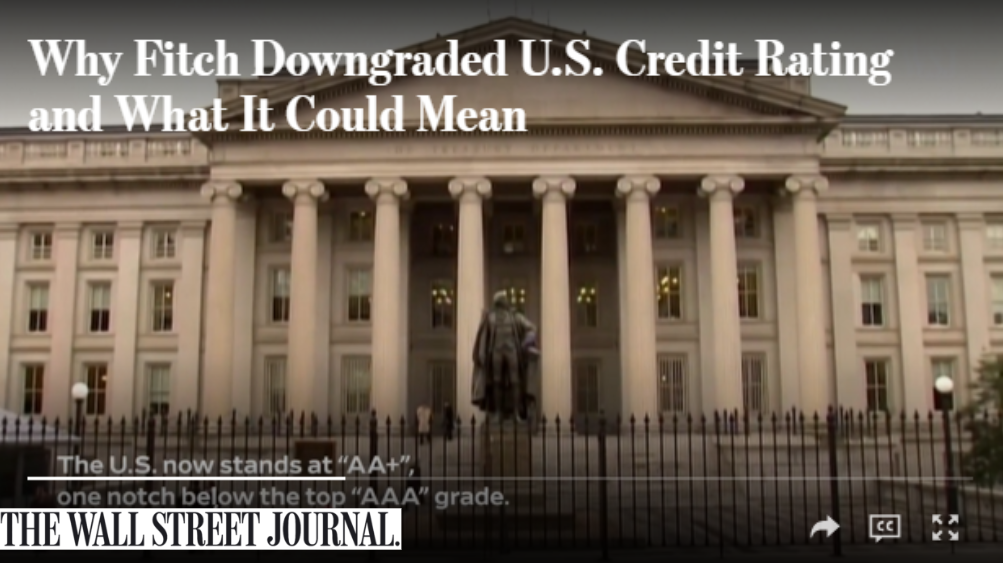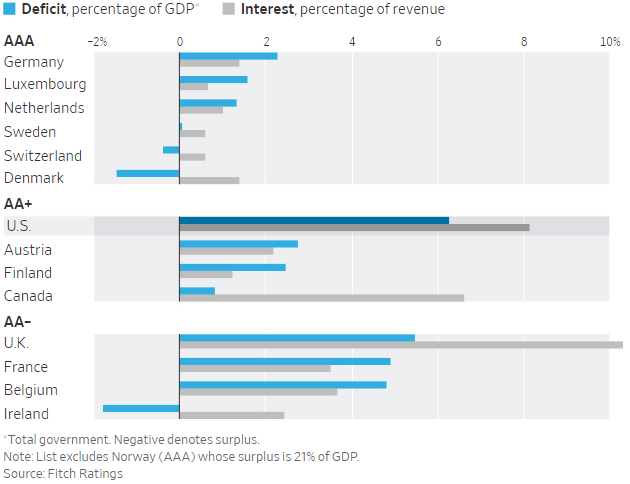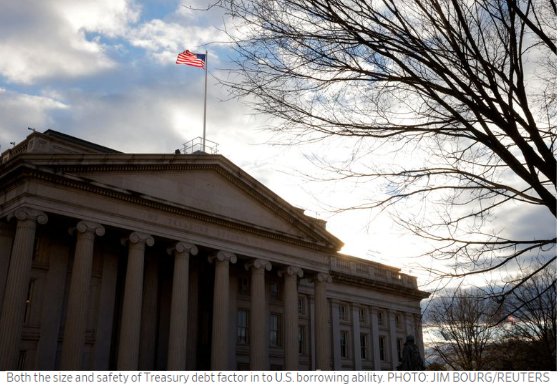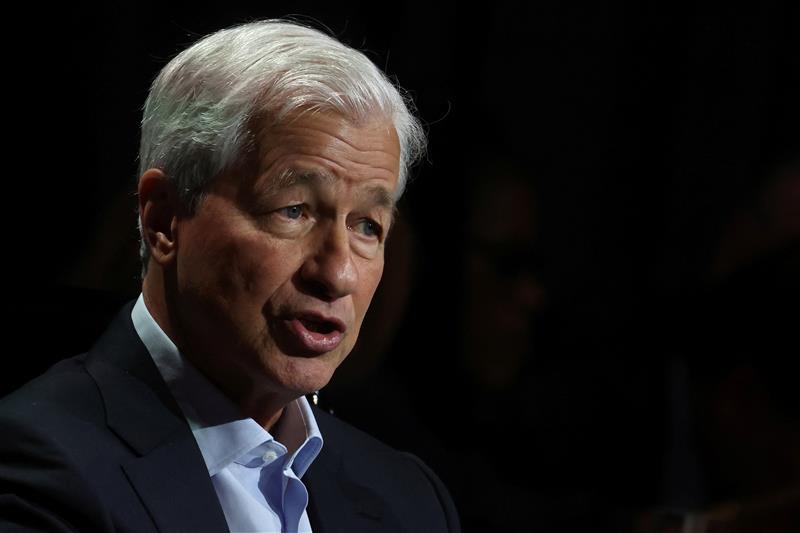
- Fitch Ratings’ decision to strip the U.S. of its triple-A credit rating last week was widely dismissed as meaningless
- This time, though, bond yields rose. That suggests Fitch’s action deserves our attention, not because it tells us anything new but because it joins the stack of evidence of how profoundly different, and risky, the nation’s fiscal situation is now.
- Instead, the Congressional Budget Office on Tuesday upped its estimate of this year’s deficit to $1.7 trillion, or 6.5% of GDP
- The second takeaway is that interest rates have gone from a stabilizing to a destabilizing factor for government finances.
U.S. debt is in much riskier territory than when S&P lowered its rating in 2011
The Biden administration criticized Fitch’s decision to downgrade the U.S. credit rating, which the rating agency said was based on political dysfunction. WSJ Asia Markets Editor Matthew Thomas outlines reaction to the decision. Photo: Saul Loeb/AFP
Fitch Ratings’ decision to strip the U.S. of its triple-A credit rating last week was widely dismissed as meaningless. After all, Standard & Poor’s had done the same back in 2011 and bond yields declined—implying more, not less, appetite for Treasury debt.
This time, though, bond yields rose. That suggests Fitch’s action deserves our attention, not because it tells us anything new but because it joins the stack of evidence of how profoundly different, and risky, the nation’s fiscal situation is now.

The risk isn’t of a debt crisis that locks the U.S. out of the markets, as happened to Greece in 2010 or Mexico in 1994; that is virtually impossible for a mature country that borrows in its own currency. The risk, rather, is of deficits and interest rates feeding back on each other at growing cost to both economic growth and taxpayers.
Federal budget deficits can’t be viewed in isolation. When S&P downgraded the U.S. back in 2011, the deficit was equivalent to 8.4% of gross domestic product, close to a post-World War II high. But in the wake of the 2007-09 recession, such deficits were both easy to finance and necessary. Private investment was subdued, unemployment at 9%, underlying inflation below the Federal Reserve’s 2% target and interest rates stuck at around zero.
Without federal borrowing, all of that—a combination later labeled “secular stagnation”—would have been worse.
Goodbye, global saving glut
Today’s circumstances are just the opposite. Private investment is healthy, unemployment near a 53-year low at 3.5%, and interest rates above 5% as the Fed combats inflation roughly double its 2% target. No one talks about secular stagnation now. This is when spending restrictions and tax increases should be in vogue.
Instead, the Congressional Budget Office on Tuesday upped its estimate of this year’s deficit to $1.7 trillion, or 6.5% of GDP, compared with 5.5% last year. In May, President Biden struck a deal with House Republicans that barely alters the trajectory of rising debt.
The variable that best captures the change in circumstances is the real Treasury yield—what investors expect to earn on a 10-year note after inflation. It was around zero in August 2011, soon to go negative. Today, it is 1.7%, near the highest since 2009.
American Exceptionalism
Deficits and debt interest of countries rated AAA or AA, 2023 estimate

One takeaway is that the global saving glut—the wall of money in search of safe assets that kept yields down a decade ago—is no more. The Fed, which was buying bonds to hold down interest rates back then (“quantitative easing”) is now disposing of those bonds (“quantitative tightening”).
Adding central bank transactions and new government borrowing, independent economist Phil Suttle estimates private investors will be asked to absorb government debt worth 7.7% of developed economies’ GDP this year and 9.2% next, more than double the 4.3% of 2011. Private borrowers thus face competition from governments for capital, which in the long run hurts investment and growth. We got a taste of that last week when yields jumped on news of larger-than-expected quarterly Treasury auctions.
Of course, more than government borrowing is putting upward pressure on bond yields. So is inflation and the perception the Fed will have to keep short-term rates high to push it down. But the two are related: Investors may worry that a future government uses inflation to reduce the real value of its debts, which raises interest rates today.
From debt stabilizer to destabilizer
The second takeaway is that interest rates have gone from a stabilizing to a destabilizing factor for government finances. When the real interest rate is below the rate of future economic growth, the debt tends to fall relative to GDP. In 2011, that gap reached 2.5 percentage points.
Because this made debts more sustainable, it is one reason governments felt no pressure to reduce them. Indeed, it was part of the mind-set that led the Biden administration to implement a blowout $1.9 trillion stimulus package in 2021.

Today, with rates higher and future growth lower than in 2011, the gap between real rates and growth is around zero. That makes interest expense a growing source of deficits, climbing from 1.9% of GDP last year to 3.7% in 2033, according to the CBO.
One reason for Fitch’s downgrade was the absence of any political will to deal with the main drivers of the deficit: spending programs for older Americans, including Social Security and Medicare, and repeated cuts to tax rates for most households.
Fitch noted how much worse U.S. fiscal metrics are than its peer countries. To give one example: The U.S. is on track to spend 10% of federal revenue on interest by 2025, compared with just 1% for the average triple-A-rated country and 4.8% for double-A-rated. Why, then, isn’t the U.S. rating even lower? Because the reserve status of the dollar and the size and safety of Treasury debt gives the U.S. unprecedented borrowing ability.
Indeed, it was hard to get presidents or Congress to worry about the deficit when interest rates were low. Today, a bond market signaling that the world is no longer safe for deficits may be the first step to tackling them.
Story by Greg Ip - Redacted bullet points by Jody Davis https://www.wsj.com/articles/fitch-downgrade-us-credit-rating-4ad98230



